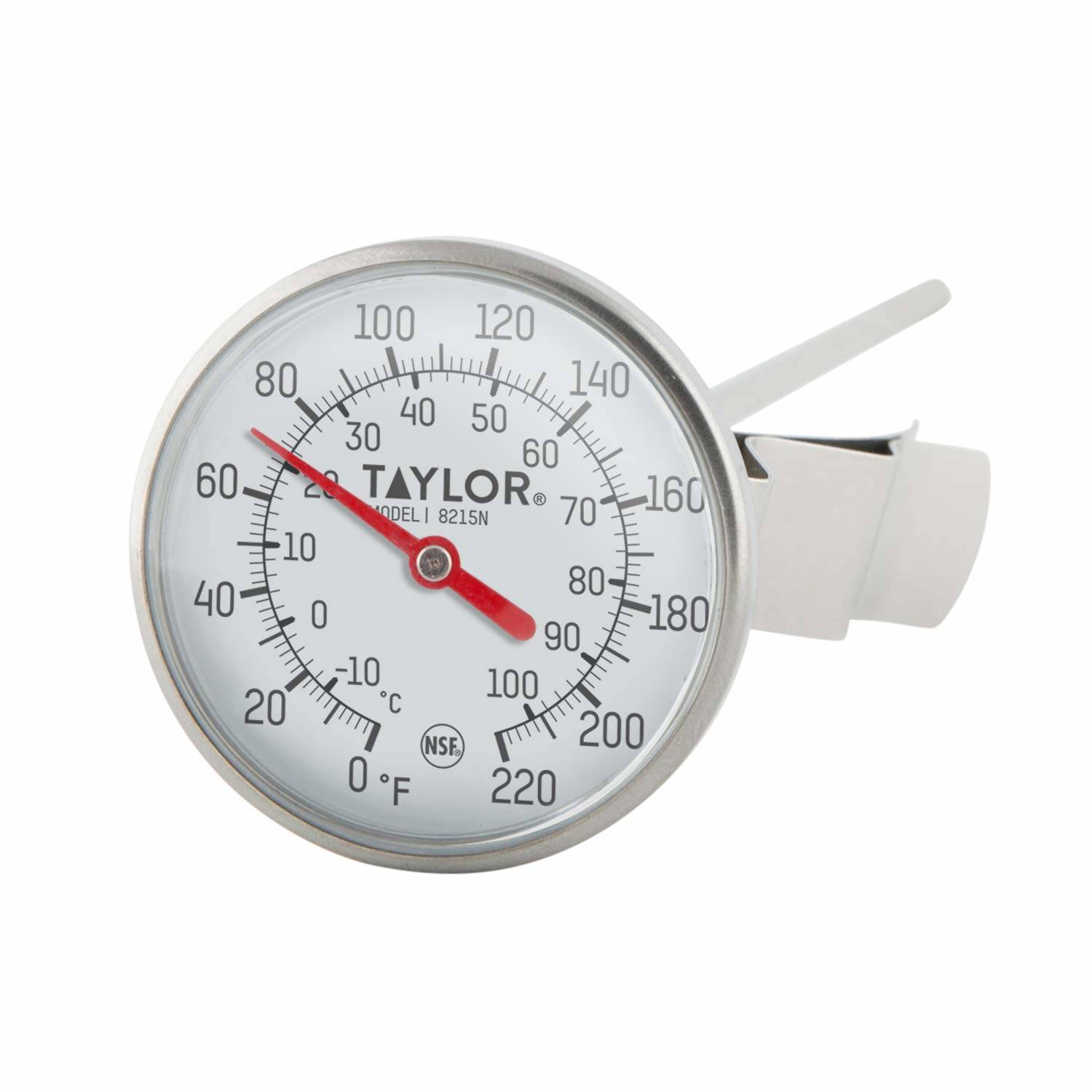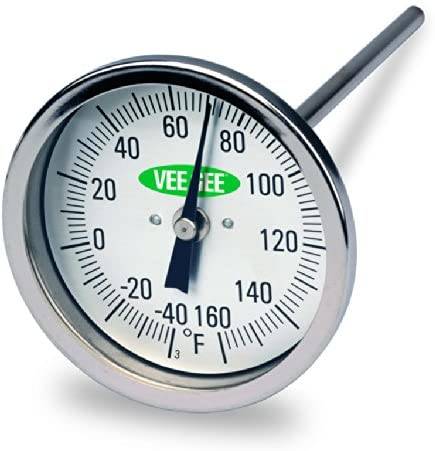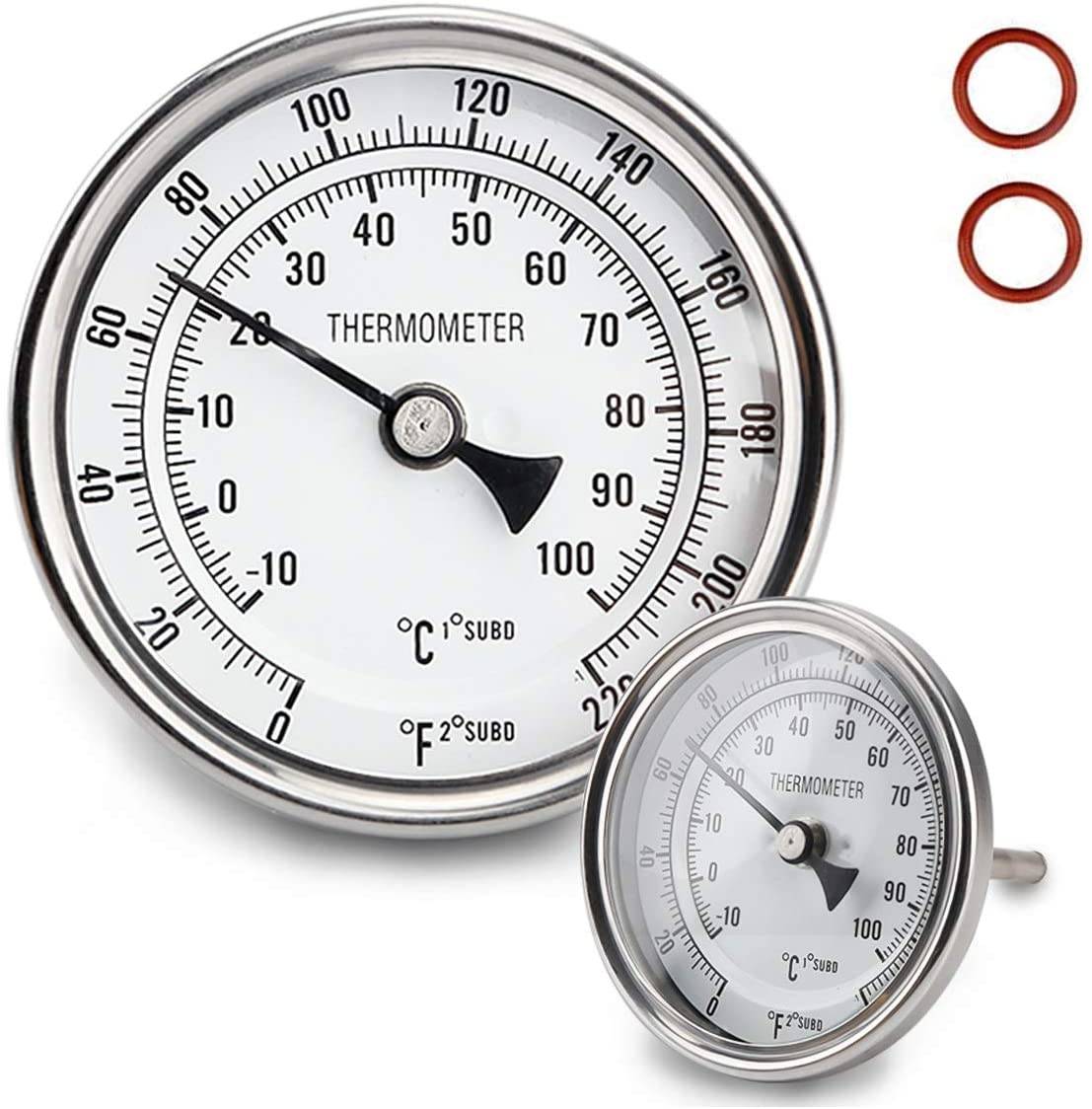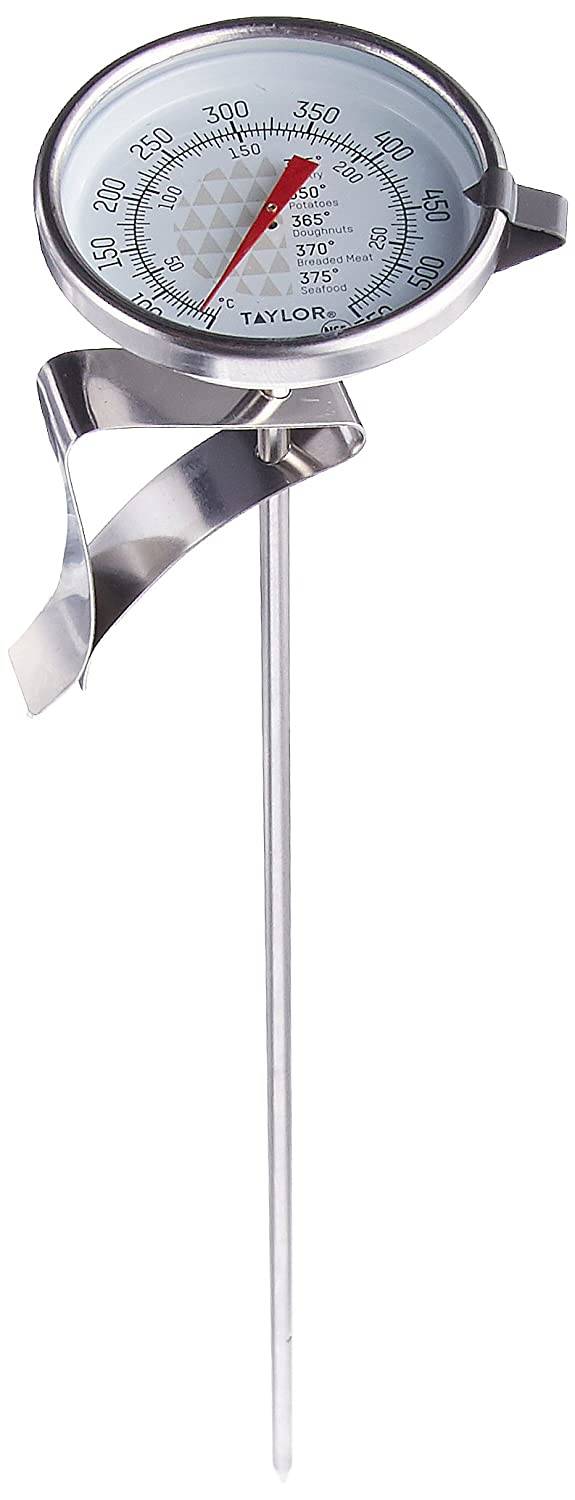Best Dial Thermometers
Have you ever thought about buying a dial thermometer?
Dial thermometers have a needle that you insert into the item that needs to be checked for temperature. The needle is the temperature sensor. At the other end of the thermometer is a circular scale with a metal pointer that shows you the temperature of your item by moving along the scale. As the temperature gets hotter, the pointer moves up the scale.
This type of thermometer has a wide range of purposes, including for general lab and engineering use, such as for soil and compost testing, and asphalt/concrete testing. But if you are using a dial thermometer in your home, most likely it will be for checking the temperature of your food and beverages. But there are other uses you might want it for at home, such as if you have an outdoor project where you need to check the temperature of your soil.
Let’s find out about some of the best dial thermometers on the market today:
Best for hot and cold drinks: Taylor Precision 8215N Pocket Dial Thermometer
The Taylor Precision 8215N Pocket Dial Thermometer has a pocket-sized dial that measures 1.75 inches in diameter. The stem of the thermometer is 8 inches long, which means it is long enough to reach far into your pitcher or stock pot (but make sure not to touch the tip of the stem to the bottom of your pot). It weighs 0.10 pounds.
This thermometer has a clip you can use to attach it securely to frothing cups to check the temperature of your favorite latte, chai tea, or other hot beverage. It can also be clipped to a stock pot to check the temperature when you are melting chocolate or butter, or even if you are making ice cream.
The temperature range on this device is from 0 to 220 degrees Fahrenheit. The temperature scale is calibrated which gives it a high accuracy of ± 2 degrees. This means if the scale says your item is 50 degrees Fahrenheit, you can rest assured it is within 48 to 52 degrees.
The wide temperature range ensures you can easily and accurately determine the best temperature at which to froth your beverage (since different drinks froth at different temperatures) or make your ice cream.
This thermometer has high visibility graphics on the dial, and therefore it is easy to read. It has what is called an anti-parallax design. This means the dial is not flat. Instead, the outer ring of the dial is slightly raised and designed in a way that allows more accurate reading of the pointer from different angles. The anti-parallax design prevents distortion of the temperature and thus ensures your reading is accurate.
This device has a watertight lens and it is constructed of stainless steel, which means it is durable and will stand up to repeated, heavy use.
The Taylor 8215N thermometer meets the safety standards set by the National Safety Foundation (NSF) International so you can rest assured it is constructed with your health in mind. It also has superior shock protection which keeps it from breaking if you accidentally drop it.
The thermometer can be easily recalibrated when needed, which keeps it accurate. Because it is most often used at a high temperature, you should calibrate it in boiling water. Follow the manufacturer’s instructions for further information on calibrating your device.
This device is easy to clean. Just make sure not to use it in your dishwasher. Instead, just use hot soapy water on the stem and use a damp cloth to wipe the head.
Features
- 75 inch diameter dial and 8 inch stainless steel stem
- Can be clipped to frothing cup or stock pot for easy temperature taking
- High visibility graphics
- Wide temperature range from 0 to 220 degrees Fahrenheit
- Meets NSF safety standards
- Very durable
Most versatile: Vee Gee Scientific 82160-6 Dial Soil Thermometer
The Vee Gee Scientific 82160-6 Dial Soil Thermometer has a 3 inch glass covered dial display and a durable, 6 inch stainless steel stem.
It has a very wide temperature range from -40 to 160 degrees Fahrenheit and can be used for all sorts of purposes. These include checking your food and beverage temperatures, but also evaluating the temperature of your soil before planting your garden. Soil temperature needs monitoring because it is very important to the uptake of water and nutrients in your plants.
Due to the wide range of temperatures covered by this thermometer, it comes in handy for checking the outside temperature when hiking or camping in any weather – hot or snowy and cold. Scientists also use it for engineering purposes, to test the temperature of concrete and other materials.
At 0.4 pounds, this thermometer is considerably heavier than the Taylor 8215N, but it still weighs less than a can of soda.
It is easy to calibrate. Simply use the adjustment nut on the back of the device to calibrate it.
If you frequent your local lending library, this is the brand of dial thermometer you are often likely to find, because it is so versatile, not just for food and drinks but for many other purposes.
Features
- 3 inch diameter dial and 6 inch stainless steel stem
- Wide temperature range from -40 to 160 degrees Fahrenheit
- Very versatile
- Easy to calibrate
Best for brewing beer: Jansamn 1/2 NPT 304 SS Dial Thermometer
Brewing beer requires a much more precise and accurate temperature reading than that provided by a regular food thermometer, in order to achieve exceptional results. The Jansamn 1/2 NPT 304 SS Dial Thermometer provides this precision and accuracy. It is primarily used for brewing beer at home, although it can be used to measure the temperature of any beverage or meat.
It has a 3 inch diameter glass display with large lettering and a 2 inch probe. The glass is hermetically sealed which ensures it will last a long time. This thermometer also has 0.5 inch of national pipe threading (NPT) so it can be installed in a beer brewing kettle that has a 0.5 inch FPT port.
This is a great thermometer for measuring the temperature of the wort from your beer as it passes through the brew pot or heat exchanger. It gives an instant temperature reading as the wort passes over the probe. You can also use this thermometer to monitor your chilled wort’s temperature as it passes through a wort chiller.
Unlike other dial thermometers, those used for brewing beer should show the temperature in both Fahrenheit and Celsius. This Jansamn brand does this, and its range is 0 to 220 degrees Fahrenheit or -10 to 100 degrees Celsius.
Also, a good dial thermometer for brewing beer needs to be recalibrated frequently, and should have the ability to be calibrated with ice water or boiling water, as this model does.
This thermometer weighs 0.45 pounds, so just slightly more than a can of pop.
The thermometer and its accompanying nut and washer are all made of durable food grade stainless steel, which is strong and resistant to corrosion. The sturdy metal stem will not break easily. The accompanying ‘O-ring’ is made of food grade silicone.
Features
- 3 inch glass display, 2 inch probe, and 0.5 inches of threading
- Temperature range 0 to 220 degrees Fahrenheit; readings also available in Celsius
- High accuracy and precision, suitable for beer brewing
- Instant temperature reading as wort passes over the probe
- Made of durable food grade stainless steel
Best for deep frying: Taylor 3522 TruTemp Series Candy / Deep Fry Analog Dial Thermometer
Ever tried to deep fry a turkey? Look no further than the Taylor 3522 TruTemp Series Candy / Deep Fry Analog Dial Thermometer, specially made for deep frying. Its 1.75 inch diameter dial and 12 inch stem makes it easy to use when monitoring the temperature of your oil while frying. It has an adjustable pan clip so you can attach it to your fryer kettle. It also comes with a handy list of temperatures at which to keep your oil when deep frying common foods.
This thermometer is also very handy when making delicate liquid candy mixes.
The temperature indicator has a red pointer and it allows you to adjust the target temperature. It measures from 50 to 550 degrees Fahrenheit. The accuracy of this thermometer, and its ease of recalibration, will ensure that your finished product is perfectly done every time.
This thermometer is quite light at 0.13 pounds, and it meets the safety standards set by NSF International.
Features
- Long stem is handy when working with hot oil
- Adjustable clip to attach to fryer kettle
- Handy for deep frying a turkey or making delicate candy mixes
- Easy recalibration
Dial thermometer FAQs
What are the different types of dial thermometers?
There are a few types of dial thermometers, each of which work slightly different from the others. These include the bimetal, liquid- or gas-filled, or vapor-tension thermometers.
A lot of dial thermometers used for the home are bimetal thermometers. This type of dial thermometer uses a coil spring made of two types of metal attached to each other by welding. One of these metals has low heat sensitivity and the other has high heat sensitivity. When heated, the two metals expand to different lengths depending on their heat sensitivity, and they make the bi-metallic strip in the thermometer bend in a certain way. This contraption includes a pointer, and when the bi-metallic strip bends, it moves the pointer to a specific spot on the dial’s temperature scale which indicates the temperature of the item to the user. Bimetal thermometers are affordable, durable, easy to use, and accurate for a wide range of temperatures. However, some bimetal thermometers have issues with calibration and are not as accurate as glass thermometers.
Liquid- or gas-filled dial thermometers use a liquid or gas as the element that senses the temperature. The liquid or gas expands as the temperature increases, and this is what determines the temperature. This type of dial thermometer usually has a small glass tube and glass bulb. The liquid or gas enters the tube and fills it. As the heat of the substance rises, it pushes the liquid or gas up the tube, and this determines the temperature, which is shown on the dial.
Vapor-tension-based dial thermometers are filled with a permanent vapor that comes from a liquid. The type of liquid used depends on what range of temperatures the thermometer measures. As the temperature increases, the liquid gives off more vapor. The temperature is measured at the point where the liquid meets the vapor. This type of dial thermometer is less expensive and most likely to be used as part of an HVAC system.
What are some important characteristics to look for in a dial thermometer?
Display options are important. These include whether the temperature is shown in Fahrenheit or Celsius or both, and what the minimum and maximum temperature readings are. Traditionally, dial thermometers have a display that is round with notches that indicate the temperature and a needle that points to the temperature. The diameter of the dial is another important consideration, as some can be as small as 1 inch some as large as 5 inches in diameter. Also, some dial thermometers come with a digital display.
The temperature sensor, also called the probe, can come in a wide variety of materials and can have different sensitivities. Also, the stem, which goes into the item being measured, can be very short – just a couple of inches – to super long – up to 80 inches.
There are some thermometers with special features. For example, some only measure temperature at the surface, rather than having to be immersed into the item being measured. Pocket style thermometers have a dial small enough to fit into a pocket. And some thermometers have NPT threading so they can be attached, for example, to a beer brewing apparatus.
With the wide range of types of dial thermometers and varieties of features, there is sure to be one that suits your purpose. However, the options can be overwhelming. Take some time to research the brands available for your particular needs, before making that purchase.




